It has been the dream of visionaries since the days of the Texas republic. John Neely Bryan wanted it for Dallas. Mayor Joseph Bates wanted it for Galveston. Amon Carter and Commodore Basil Muse Hatfield wanted it for Fort Worth.
The dream: to make the Trinity River navigable six hundred miles upstream from the Gulf of Mexico. But the dream would prove elusive, in part because the Trinity is lazy—it moseys, it meanders, it zigs and zags like a drunken dervish. It also is cluttered—especially in rural areas—with log jams, sandbars, bottlenecks, shallows, snags, and overhanging trees. And on top of all that, in times of drought parts of it can be reduced to just intermittent pools.
 All of those drawbacks notwithstanding, in the beginning the dream looked so possible. In fact, beginning about 1836—the year of the Texas Revolution—steamboats of shallow draft (water displacement) traveled the Trinity River, bringing dry goods and groceries upriver and returning downriver with deer hides, cowhides, cotton, sugar, and other staples. This clip from the May 19, 1838 Weekly Houston Telegraph reported that a steamer had reached the town of Liberty twenty miles north of Trinity Bay (see map below adapted from Wikipedia).
All of those drawbacks notwithstanding, in the beginning the dream looked so possible. In fact, beginning about 1836—the year of the Texas Revolution—steamboats of shallow draft (water displacement) traveled the Trinity River, bringing dry goods and groceries upriver and returning downriver with deer hides, cowhides, cotton, sugar, and other staples. This clip from the May 19, 1838 Weekly Houston Telegraph reported that a steamer had reached the town of Liberty twenty miles north of Trinity Bay (see map below adapted from Wikipedia).
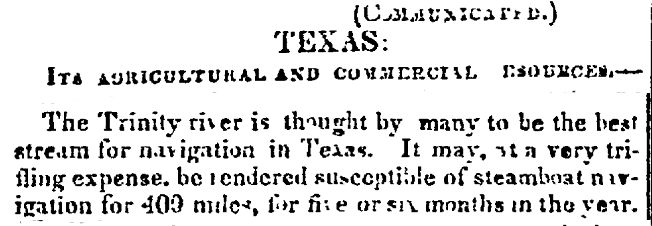 This clip from the June 23, 1838 Weekly Houston Telegraph predicted that the Trinity River could be made navigable for four hundred miles at “very trifling expense.”
This clip from the June 23, 1838 Weekly Houston Telegraph predicted that the Trinity River could be made navigable for four hundred miles at “very trifling expense.”
Famous last words.
 A person writing in the July 14, 1841 Austin City Gazette proclaimed the Trinity “an admirable stream for navigation—the Mississippi of Texas.”
A person writing in the July 14, 1841 Austin City Gazette proclaimed the Trinity “an admirable stream for navigation—the Mississippi of Texas.”
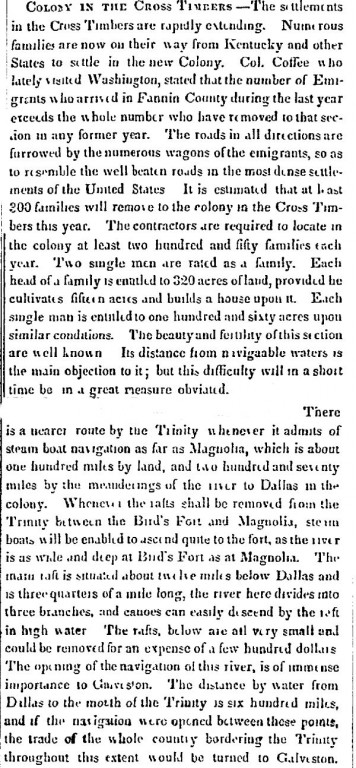 On February 21, 1844 the Weekly Houston Telegraph reported on the progress of Peters Colony but lamented the colony’s “distance from navigable waters.” But the report predicted that in a short time that problem would be “in a great measure obviated.” The report said the river was navigable by steamboats from the gulf to the town of Magnolia (see map below). Indeed, the now-vanished town of Magnolia, established in the early 1840s as a Trinity River cotton port, once called itself the “Little St. Louis of the Trinity.”
On February 21, 1844 the Weekly Houston Telegraph reported on the progress of Peters Colony but lamented the colony’s “distance from navigable waters.” But the report predicted that in a short time that problem would be “in a great measure obviated.” The report said the river was navigable by steamboats from the gulf to the town of Magnolia (see map below). Indeed, the now-vanished town of Magnolia, established in the early 1840s as a Trinity River cotton port, once called itself the “Little St. Louis of the Trinity.”
If obstructing rafts (log jams) could be removed, the Telegraph wrote, between Bird’s Fort and Magnolia, steamboats could reach the fort in Tarrant County. The main raft was twelve miles below Dallas. Smaller rafts, the report predicted, could be removed for “a few hundred dollars.”
More famous last words.
 On June 6, 1848 the Clarksville Northern Standard reported on a meeting in Dallas. On May 24 citizens had met to select delegates to attend a convention in Huntsville to discuss making the Trinity River navigable all the way to the mouth of the Clear Fork. Chairman of the Dallas meeting was General Edward H. Tarrant.
On June 6, 1848 the Clarksville Northern Standard reported on a meeting in Dallas. On May 24 citizens had met to select delegates to attend a convention in Huntsville to discuss making the Trinity River navigable all the way to the mouth of the Clear Fork. Chairman of the Dallas meeting was General Edward H. Tarrant.
Also present was Albert Gallatin Walker. Walker was a surveyor, journalist, and state senator. In the 1850s he would move to Birdville, where he campaigned for Birdville in the Birdville-Fort Worth county seat rivalry, founded the Birdville Union newspaper, and fatally shot a fellow Birdville journalist.
Notice also the name of John Neely Bryan, founder of Dallas.
The resolution drawn up at the meeting declared that the Trinity River “waters and runs through the best portion of the Lord’s Green Earth” and that “we believe said River with comparatively small expense can be made navigable to the mouth of Clear Fork, which is about one hundred miles (by water) west and above the town of Dallas.”
“Small expense”? Again with the famous last words! (Are you detecting a trend here?)
The mouth of the Clear Fork, of course, is the confluence of the Clear Fork and West Fork—the site chosen by Ripley Arnold for the Army’s Fort Worth in 1849. That description of the mouth of the Clear Fork—“one hundred miles (by water) west and above the town of Dallas”—does not match a modern description. Granted, the course of the Trinity between Fort Worth and Dallas has been shortened as a flood-control measure and today is only about fifty-five miles long.
 In 1848 other affected towns also held meetings and sent delegates to the Huntsville meeting. Galveston, being a seaport near the mouth of the Trinity, had an especially vested interest in the river being made more navigable. Galveston Mayor Joseph Bates was chairman of that meeting.
In 1848 other affected towns also held meetings and sent delegates to the Huntsville meeting. Galveston, being a seaport near the mouth of the Trinity, had an especially vested interest in the river being made more navigable. Galveston Mayor Joseph Bates was chairman of that meeting.
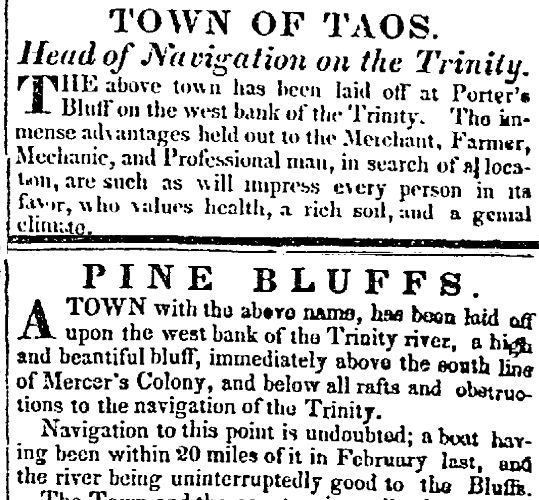 The Trinity River was booming in 1848. Two new towns on the river—Taos (Porter’s Bluff in Navarro County) and Pine Bluff (Freestone County; see map below)—ran ads in the May 27 Clarksville Northern Standard promoting their advantages as river ports. Taos claimed to be the northernmost port on the river. It was used by shallow-draft steamboats that traveled the Trinity before the Civil War, hauling supplies upriver and hauling cotton downriver.
The Trinity River was booming in 1848. Two new towns on the river—Taos (Porter’s Bluff in Navarro County) and Pine Bluff (Freestone County; see map below)—ran ads in the May 27 Clarksville Northern Standard promoting their advantages as river ports. Taos claimed to be the northernmost port on the river. It was used by shallow-draft steamboats that traveled the Trinity before the Civil War, hauling supplies upriver and hauling cotton downriver.
Both Porter’s Bluff and Pine Bluff, like Magnolia, have vanished.
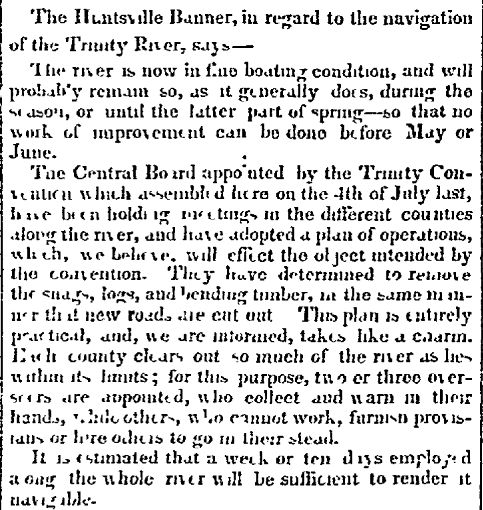 The January 25, 1849 Weekly Houston Telegraph reported that the board appointed at the 1848 Huntsville convention devised a plan “to remove the snags, logs, and bending timber in the same manner that new roads are cut out.”
The January 25, 1849 Weekly Houston Telegraph reported that the board appointed at the 1848 Huntsville convention devised a plan “to remove the snags, logs, and bending timber in the same manner that new roads are cut out.”
“It is estimated that a week or ten days employed along the whole river will be sufficient to render it navigable.”
“A week or ten days”? Yet more famous last words.
By 1849, of course, Texas was part of the Union. After the Huntsville convention, Congress in 1852 authorized $3,000 to survey the river. Lieutenant William Whiting of the Army Corps of Engineers deemed the Trinity “the deepest and least obstructed river in the State of Texas” and reported that the river could be improved for $31,800 ($914,000 today). But Congress failed to appropriate the money.
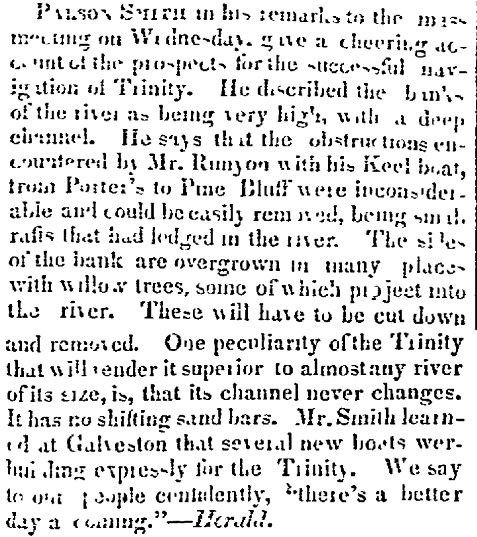 Nonetheless, optimism continued to flow through the Trinity valley. The June 20, 1850 Weekly Houston Telegraph reprinted the (Dallas?) Herald’s report that “the obstructions encountered by Mr. Runyon with his Keel boat from Porter’s [Bluff] to Pine Bluff were inconsiderable and could be easily removed, being small rafts that had lodged in the river.” The Herald ended its report with this prediction: “there’s a better day a coming.”
Nonetheless, optimism continued to flow through the Trinity valley. The June 20, 1850 Weekly Houston Telegraph reprinted the (Dallas?) Herald’s report that “the obstructions encountered by Mr. Runyon with his Keel boat from Porter’s [Bluff] to Pine Bluff were inconsiderable and could be easily removed, being small rafts that had lodged in the river.” The Herald ended its report with this prediction: “there’s a better day a coming.”
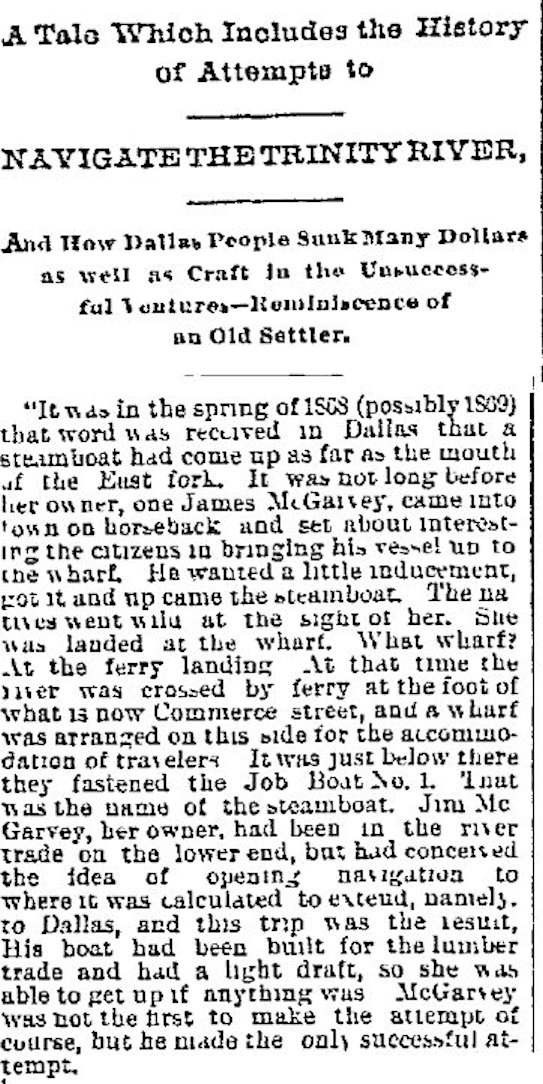 In an article in the Dallas Morning News of July 14, 1889 an “old settler” remembered attempts to make the Trinity River navigable to Dallas and recalled one attempt to reach Dallas by steamboat that was successful.
In an article in the Dallas Morning News of July 14, 1889 an “old settler” remembered attempts to make the Trinity River navigable to Dallas and recalled one attempt to reach Dallas by steamboat that was successful.
Well, sorta.
In 1868 a shallow-draft steamboat had traveled as far upstream as the mouth of the East Fork of the Trinity. The East Fork is the easternmost of the four forks of the Trinity, and its mouth is several miles southeast of Dallas (see map below). The owner of the boat rode into Dallas on horseback and recruited people to help him move the boat the rest of the way to Dallas. The report does not say how those people coaxed the boat those last several miles. But the steamboat did dock at the ferry landing at the foot of what is now Commerce Street, and “the natives went wild.” The “old settler” said that was the only time a steamboat ever reached Dallas.
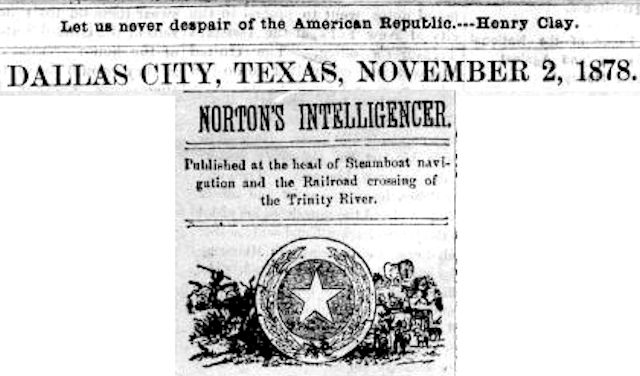 Nonetheless, in 1878 A. B. Norton‘s Intelligencer newspaper optimistically proclaimed Dallas to be the “head of Steamboat navigation and the Railroad crossing of the Trinity River.”
Nonetheless, in 1878 A. B. Norton‘s Intelligencer newspaper optimistically proclaimed Dallas to be the “head of Steamboat navigation and the Railroad crossing of the Trinity River.”
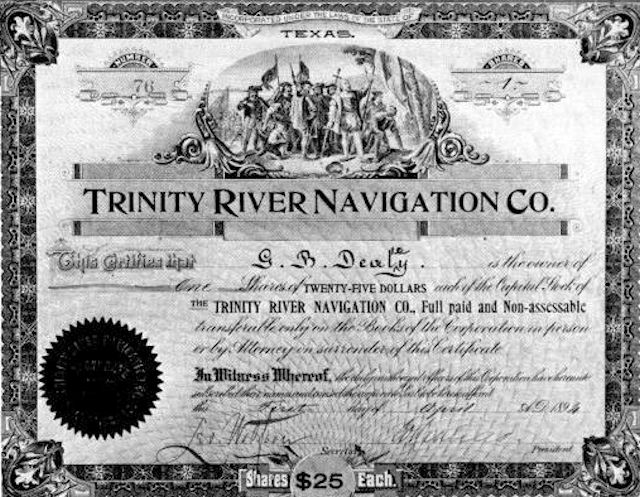 And in 1891 the Trinity River Navigation Company would organize in Dallas and issue stock. Among the stockholders was Dallas Morning News publisher G. B. Dealey. (Photo from the Dallas Historical Society.)
And in 1891 the Trinity River Navigation Company would organize in Dallas and issue stock. Among the stockholders was Dallas Morning News publisher G. B. Dealey. (Photo from the Dallas Historical Society.)

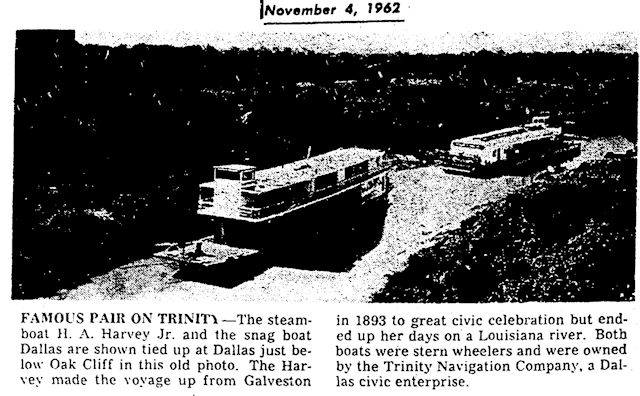 In 1893 the Trinity River Navigation Company’s steamboat Harvey would reach Dallas from Galveston after the snag boat Dallas (top photo) cleared the last twenty miles of snags in the river in southeast Dallas County. The crew of the Harvey also had to clear snags and overhanging trees as it poked along northward. (Photo from the Dallas Historical Society.)
In 1893 the Trinity River Navigation Company’s steamboat Harvey would reach Dallas from Galveston after the snag boat Dallas (top photo) cleared the last twenty miles of snags in the river in southeast Dallas County. The crew of the Harvey also had to clear snags and overhanging trees as it poked along northward. (Photo from the Dallas Historical Society.)
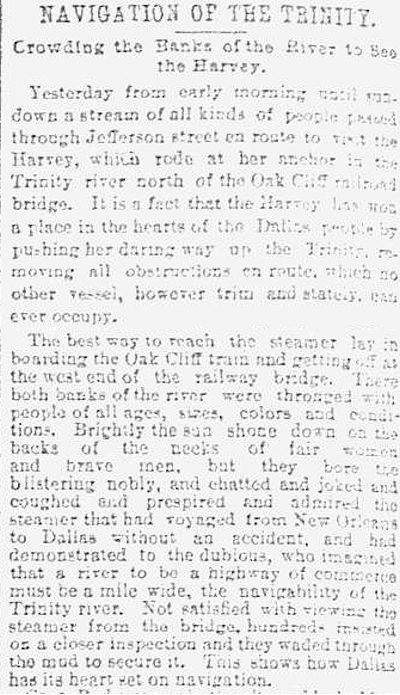 On May 21, 1893 the Harvey reached Dallas. Throngs of people went down to the river to marvel at the steamboat. “Dallas has its heart set on navigation,” the Dallas Morning News wrote on May 22 as optimism for Trinity River navigation soared. But that optimism soared only briefly. Lack of constant water level in the river made navigation unreliable. When the water was too high, bridges became an obstacle. When the water was too low, the river bottom became an obstacle. Soon the Harvey was relegated to use as an excursion boat between Dallas and McCommas Bluff twelve miles south of town.
On May 21, 1893 the Harvey reached Dallas. Throngs of people went down to the river to marvel at the steamboat. “Dallas has its heart set on navigation,” the Dallas Morning News wrote on May 22 as optimism for Trinity River navigation soared. But that optimism soared only briefly. Lack of constant water level in the river made navigation unreliable. When the water was too high, bridges became an obstacle. When the water was too low, the river bottom became an obstacle. Soon the Harvey was relegated to use as an excursion boat between Dallas and McCommas Bluff twelve miles south of town.
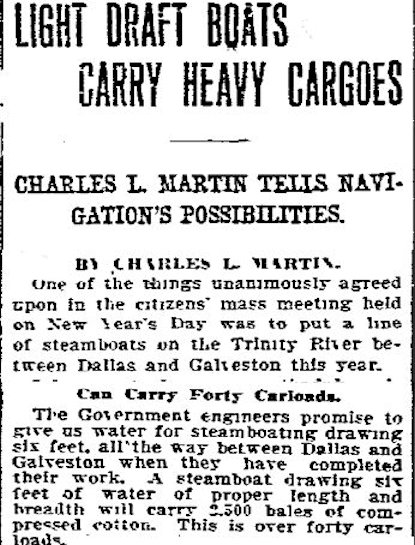 Despite the challenges, the dream of navigating the Trinity River continued into the twentieth century. On January 31, 1909 the Dallas Morning News reported that citizens attending a mass meeting had made a New Year’s resolution to launch a line of steamboats on the river between Dallas and Galveston that year. The report said government engineers had promised to make the river deep enough for steamboats that drew six feet of water to reach Dallas.
Despite the challenges, the dream of navigating the Trinity River continued into the twentieth century. On January 31, 1909 the Dallas Morning News reported that citizens attending a mass meeting had made a New Year’s resolution to launch a line of steamboats on the river between Dallas and Galveston that year. The report said government engineers had promised to make the river deep enough for steamboats that drew six feet of water to reach Dallas.
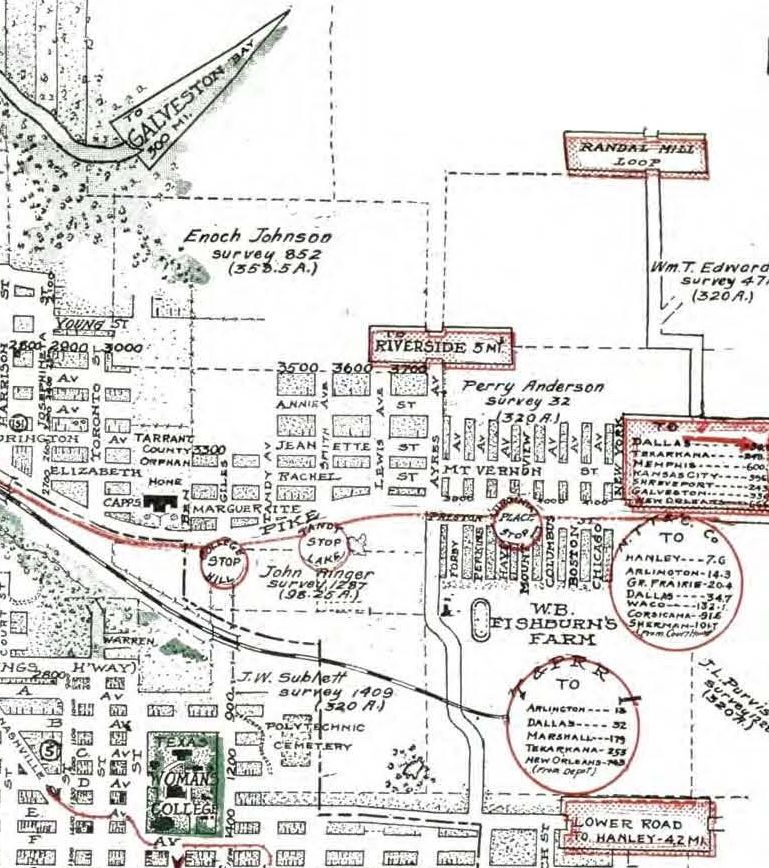 The 1920 map of Fort Worth by C. H. Rogers shows that the dream was still alive. At the edge of the map Rogers indicated distances to destinations on the railroads and the interurban. Via the Trinity River, Rogers pointed out, Galveston Bay was just five hundred miles away. (Map from Pete Charlton’s “1000+ Lost Antique Maps of Texas & the Southwest on DVD-ROM.”)
The 1920 map of Fort Worth by C. H. Rogers shows that the dream was still alive. At the edge of the map Rogers indicated distances to destinations on the railroads and the interurban. Via the Trinity River, Rogers pointed out, Galveston Bay was just five hundred miles away. (Map from Pete Charlton’s “1000+ Lost Antique Maps of Texas & the Southwest on DVD-ROM.”)
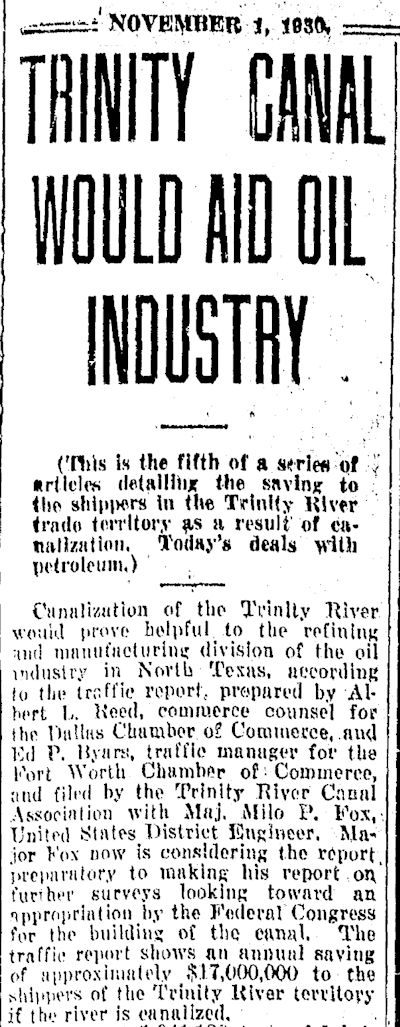 The dream of canalization continued into the 1930s. The Star-Telegram, led by publisher Amon Carter, who was Fort Worth’s most visible booster, was a major proponent of the canal dream and printed hundreds of articles touting the advantages that would accrue to Fort Worth from the canal. In 1930 the newspaper quoted a report that said the oil industry would save $17 million ($244 million today) by using the canal.
The dream of canalization continued into the 1930s. The Star-Telegram, led by publisher Amon Carter, who was Fort Worth’s most visible booster, was a major proponent of the canal dream and printed hundreds of articles touting the advantages that would accrue to Fort Worth from the canal. In 1930 the newspaper quoted a report that said the oil industry would save $17 million ($244 million today) by using the canal.
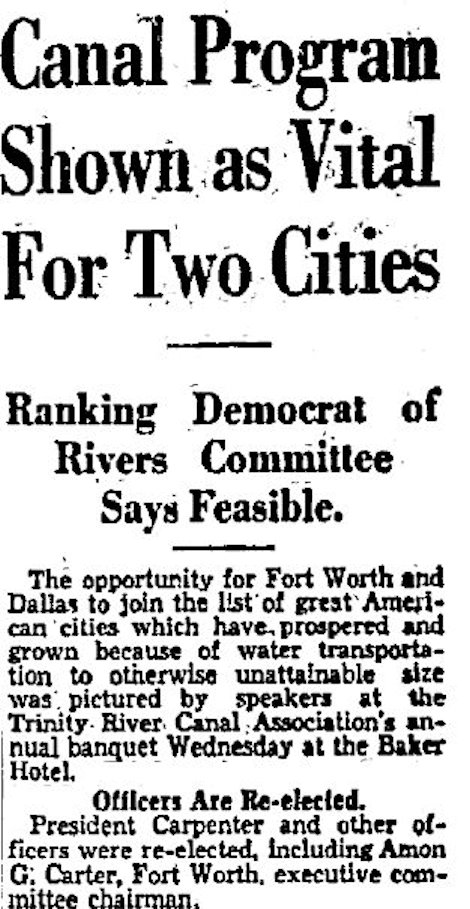 Amon Carter was busy in the 1930s, helping to bring to Fort Worth the Frontier Centennial and the bomber plant. But he found time to become the latest and largest of the canal dreamers, serving as chairman of the executive committee of the Trinity River Canal Association. Carter would campaign for canalization to Fort Worth for the remainder of his life. Clip is from the October 29, 1931 Dallas Morning News.
Amon Carter was busy in the 1930s, helping to bring to Fort Worth the Frontier Centennial and the bomber plant. But he found time to become the latest and largest of the canal dreamers, serving as chairman of the executive committee of the Trinity River Canal Association. Carter would campaign for canalization to Fort Worth for the remainder of his life. Clip is from the October 29, 1931 Dallas Morning News.
And, of course, in 1933 Commodore Basil Muse Hatfield began his voyage down the river and on to Chicago to promote canalization.
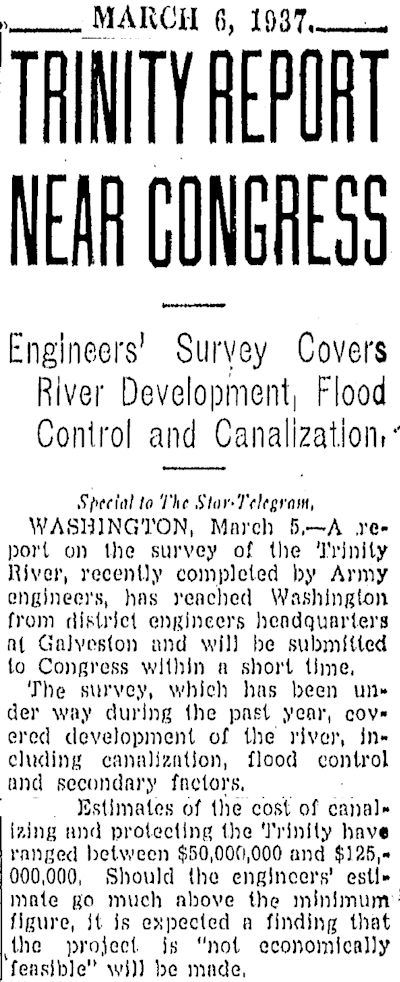 In 1936-1937 the U.S. Army Corps of Engineers conducted a survey of the river to determine the feasibility of canalization and flood control. The Star-Telegram said that if the cost of canalization and flood control was much more than $50 million ($834 million today), the project probably would be “not economically feasible.”
In 1936-1937 the U.S. Army Corps of Engineers conducted a survey of the river to determine the feasibility of canalization and flood control. The Star-Telegram said that if the cost of canalization and flood control was much more than $50 million ($834 million today), the project probably would be “not economically feasible.”
Indeed, as the twentieth century progressed, grand plans to make the river navigable to Fort Worth and Dallas flared up and fizzled out. Studies were made, funding was proposed, hundreds of newspaper articles were written.
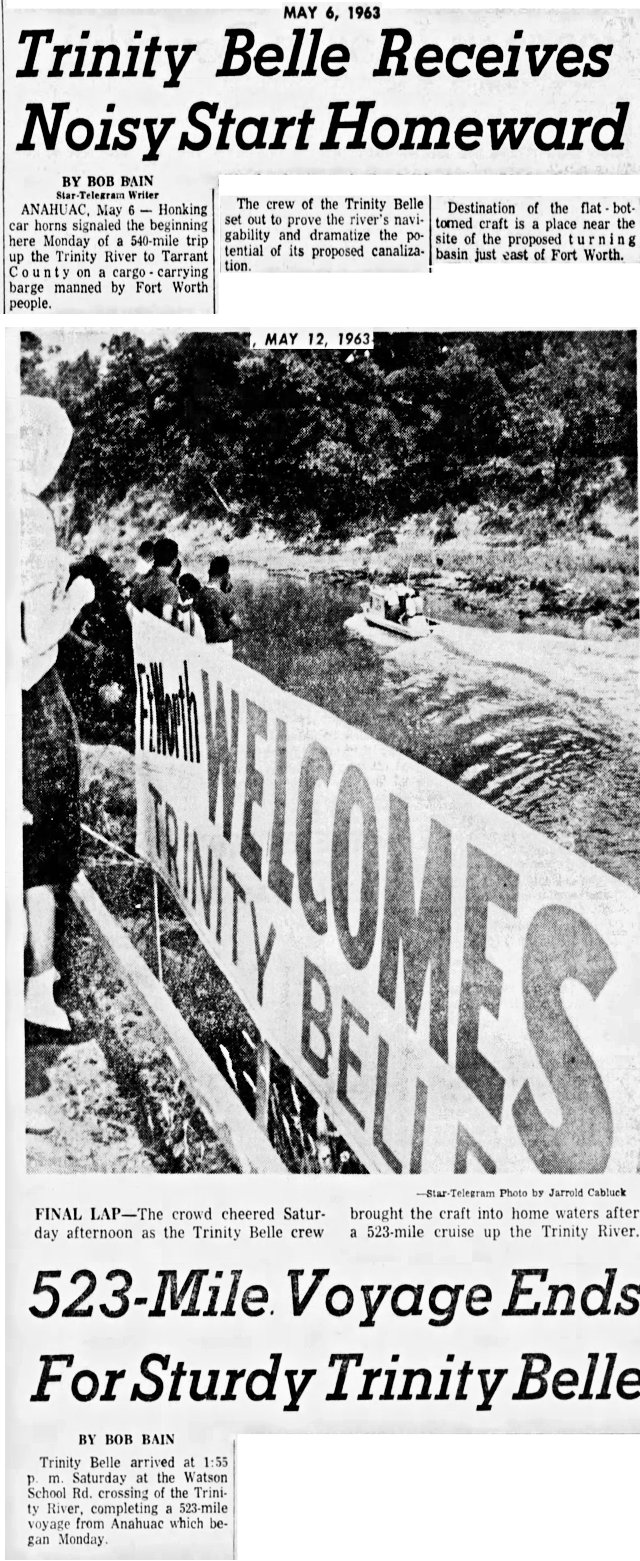 In 1963 a crew even navigated a flat-bottomed barge carrying freight from Anahuac on Trinity Bay 523 miles up the river to a site just east of Fort Worth where a turning basin for canal traffic was envisioned.
In 1963 a crew even navigated a flat-bottomed barge carrying freight from Anahuac on Trinity Bay 523 miles up the river to a site just east of Fort Worth where a turning basin for canal traffic was envisioned.
And in anticipation of canalization, some highway bridges over the river were built high enough to accommodate canal traffic.
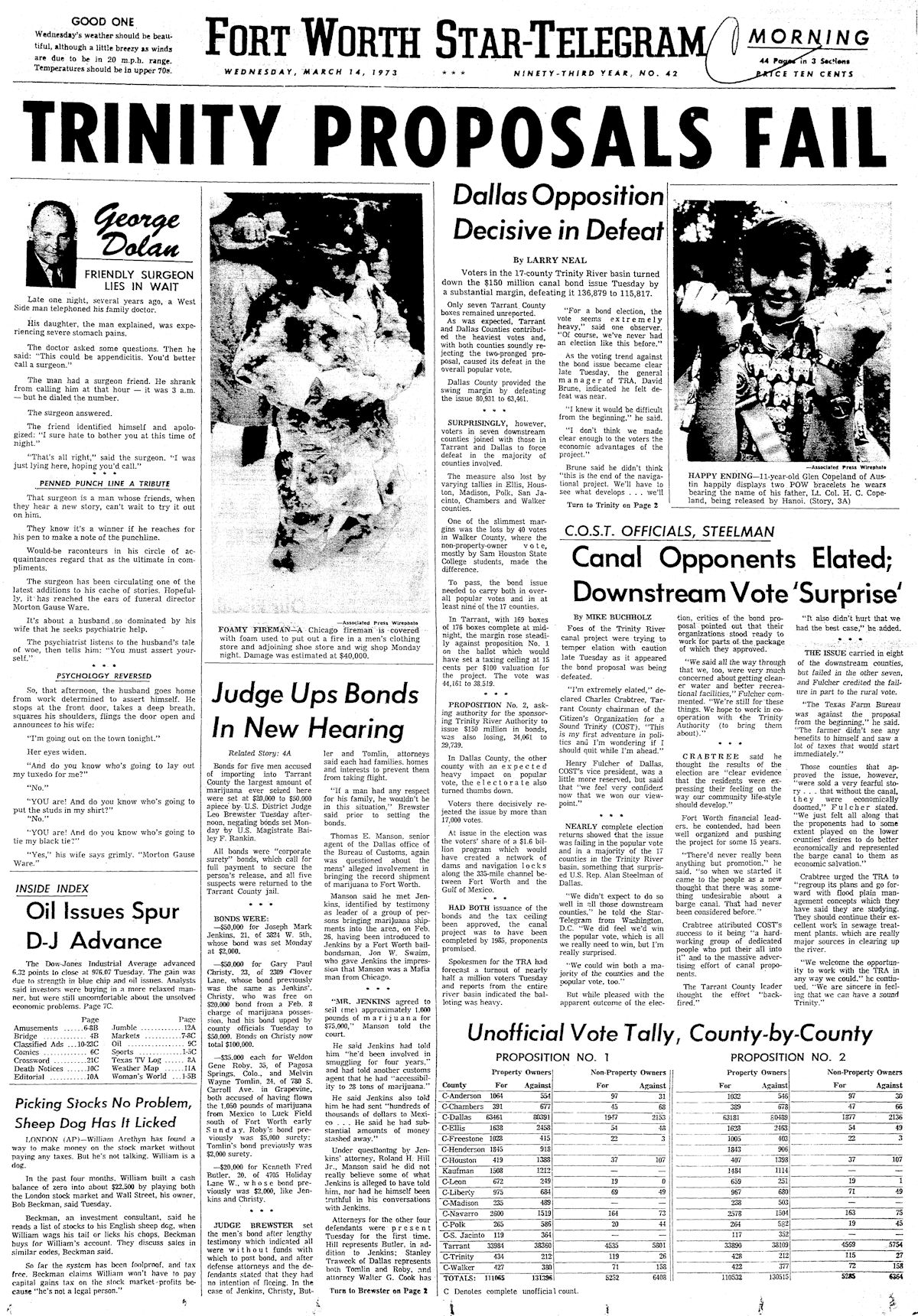 But in 1973 voters in seventeen counties of the Trinity River basin defeated two proposals to issue bonds and levy taxes to fund the canal.
But in 1973 voters in seventeen counties of the Trinity River basin defeated two proposals to issue bonds and levy taxes to fund the canal.

Four years later the outlook had not improved. The Dallas Morning News on October 26, 1977 quoted the president of the Trinity River Authority as saying that the dream of making the river navigable from the gulf to the Metroplex was “unrealistic.”
And that was the famous last word.

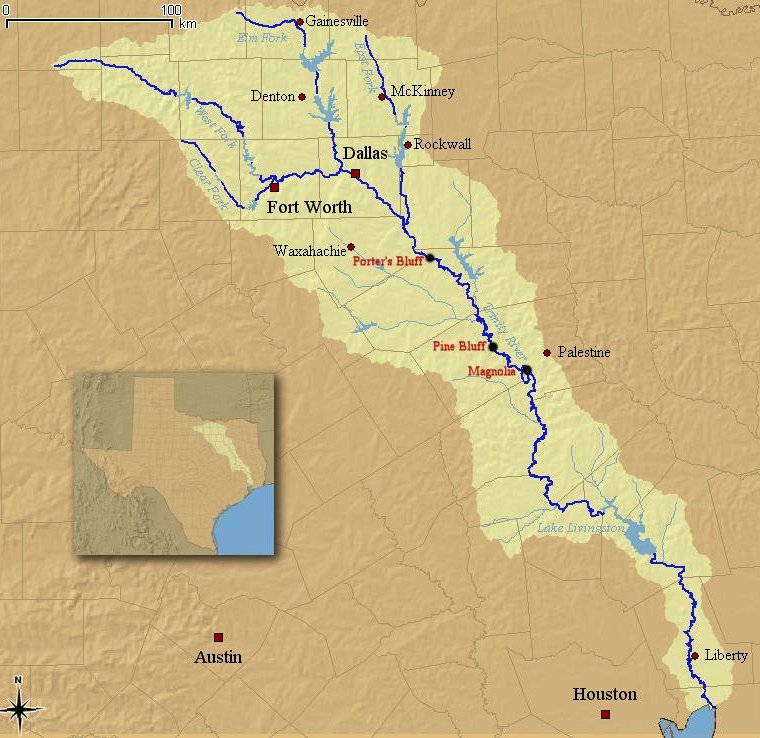





They should have known once Congress got involved nothing would get done
After taking an old time steamboat down the Mississippi, this history is amazing to me as a Dallas resident. Well done!
Thank you, Mr. Hanson. It sounded so doable in the beginning.